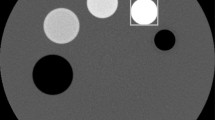Abstract
Attenuation correction is very important for quantitative SPECT imaging. We designed an uncollimated non-uniform line array source (non-uniform LAS) for attenuation correction based on transmission computed tomography (TCT) using Tc-99m and compared its performance with an uncollimated uniform line array source (uniform LAS) in a thorax phantom study. This non-uniform LAS was attached to one camera head of a dual-head gamma camera, and transmission data were acquired with another camera head with a low-energy, general purpose, parallel-hole collimator at 50 cm-distance apart from the source. The modified TEW using a subtraction factor of 1.0 was employed to correct scattered Tc-99m photons for transmission data. In the phantom experiment, eight TCT data were acquired with the scanning time changed from 2 minutes to 20 minutes for each LAS. The Tc-99m attenuation coefficient (μ) maps with the non-uniform LAS and uniform LAS improved the statistical count variation in the mediastinum filled with water as the scanning time got longer. The Tc-99m μ-map with the non-uniform LAS and 6 minutes of scanning time had equal quality at the center of the thorax phantom to that with the uniform LAS and 16 minutes of scanning time. In conclusion, for the TCT imaging with combination of the parallel hole collimator and uncollimated Tc-99m external source the non-uniform LAS can reduce the Tc-99m radioactivity or the TCT scanning time compared with the uniform LAS.
Similar content being viewed by others
References
King MA, Tsui BMW, Pan TS. Attenuation compensation for cardiac single-photon emission computed tomographic imaging: part 1. impact of attenuation and methods of estimating attenuation maps.J Nucl Cardiol 1995; 2:513- 5244.
Ogawa K, Takagi Y, Kubo A, Hashimoto S, Sannmiya T, Okano Y, et al. An attenuation correction method of single photon emission computed tomography using gamma ray transmission CT.KAKU IGAKU (Jpn J Nucl Med) 1985; 22:477–4900.
Ogawa K, Kubo A, Hashimoto S, Morozumi T, Nakajima M, Yuta S, et al. An attenuation correction of SPECT image using transmission data acquired with dual head gamma camera system.Med Imaging Technol 1985; 3S:103–1044.
Hashimoto J, Sannmiya T, Ogasawara K, Kubo A, Ogawa K, Ichihara T, et al. Scatter and attenuation correction for quantitative myocardial SPECT.KAKU IGAKU (Jpn J Nucl Med) 1996; 33:1015–10199.
Ichihara T, Maeda H, Yamakado K, Motomura N, Matsumura K, Takeda K, et al. Quantitative analysis of scatter- and attenuation-compensated dynamic single-photon emission tomography for functional hepatic imaging with a receptor-binding radiopharmaceutical.Eur J Nucl Med 1997; 24:59–677.
Kojima A, Matsumoto M, Tomiguchi S, Katsuda N, Yamashita Y, Motomura N. Accurate scatter correction for transmission computed tomography using an uncollimated line array source.Ann Nucl Med 2004; 18:45–500.
Ogawa K, Harata Y, Ichihara T, Kubo A, Hashimoto S. A practical method for position-dependent compton-scatter correction in single photon emission CT.IEEE Trans Med Imag 1991; 10:408–122.
Ichihara T, Ogawa K, Motomura N, Kubo A, Hashimoto S. Compton scatter compensation using the triple-energy window method for single- and dual-isotope SPECT.J Nucl Med 1993; 34:2216–22211.
Bailey DL, Hutton BF, Walker PJ. Improved SPECT using simultaneous emission and transmission tomography.J Nucl Med 1987; 28:844–8511.
Tsui BMW, Gullberg GT, Edgerton ER, Ballard JG, Perry JR, McCartney WH, et al. Correction of nonuniform attenuation in cardiac SPECT imaging.J Nucl Med 1989; 30:497- 507.
Tan P, Bailey DL, Meikle SR, Eberl S, Fulton RR, Hutton BF. A scanning line source for simultaneous emission and transmission measurements in SPECT.J Nucl Med 1993; 34:1752–17600.
Celler A, Sitek A, Stoub E, Harrop P, Lyster D. Multiple line source array for SPECT transmission scans: simulation, phantom and patient study.J Nucl Med 1998; 39:2183- 21899.
Ogawa K, Kubo A, Ichihara T. Estimation of scattered photons in gamma ray transmission CT using Monte Carlo simulations.IEEE Trans Nucl Sci 1997; 44:1225–12300.
Frey EC, Tsui BMW, Perry JR. Simultaneous acquisition of emission and transmission data for improved thallium-201 cardiac SPECT imaging using a technetium-99m transmission source.J Nucl Med 1992; 33:2238–22455.
Tomiguchi S, Kira T, Kojima A, Matsumoto M, Nishi J, Katsuda N, et al. Attenuation correction in Tl-201/Tc-99m myocardial SPECT.Eur J Nucl Med 1999; 26:11866.
Author information
Authors and Affiliations
Corresponding author
Rights and permissions
About this article
Cite this article
Kojima, A., Kawanaka, K., Nakaura, T. et al. Attenuation correction using combination of a parallel hole collimator and an uncollimated non-uniform line array source. Ann Nucl Med 18, 385–390 (2004). https://doi.org/10.1007/BF02984481
Received:
Accepted:
Issue Date:
DOI: https://doi.org/10.1007/BF02984481




